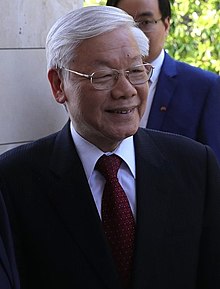General Secretary of the Communist Party of Vietnam
| General Secretary of the Central Committee of the Communist Party of Vietnam | |
|---|---|
 Symbol of the Communist Party of Vietnam | |
| Style | Comrade (Đồng chí) (Formal) |
| Type | Party leader |
| Status | 1st in Politburo and Secretariat |
| Member of | Central Committee Political Bureau Central Military Commission Secretariat |
| Appointer | Central Committee |
| Term length | Five years renewable once |
| Precursor | First Secretary |
| Inaugural holder | Trần Phú |
| Formation | 27 October 1930 |
The General Secretary of the Central Committee of the Communist Party of Vietnam (Vietnamese: Tổng Bí thư Ban Chấp hành Trung ương Đảng Cộng sản Việt Nam), known as First Secretary (Vietnamese: Bí thư Thứ nhất) from 1951 to 1976, is the highest office within the Communist Party of Vietnam.
Officeholders[change | change source]
| № [note 1] |
Portrait | Name (Birth–Death) |
Took office | Left office | Rank [note 2] |
Central Committee |
|---|---|---|---|---|---|---|
| 1 | 
|
Trần Phú (1904–1931) |
27 October 1930 | 6 September 1931 | 1 | Provisional Central Committee (1930–35) |
| 2 | 
|
Lê Hồng Phong (1902–1942) |
27 October 1931 | 26 July 1936 | 1 | 1st Central Committee (1935–51) |
| 3 | 
|
Hà Huy Tập (1906–1941) |
26 July 1936 | 30 March 1938 | 1 | |
| 4 | 
|
Nguyễn Văn Cừ (1912–1941) |
30 March 1938 | 9 November 1940 | 1 | |
| 5 | 
|
Trường Chinh (1907–1988) |
9 November 1940 | 5 October 1956 | 1 [note 3] |
1st Central Committee (1935–51) |
| 2 | 2nd Central Committee (1951–60) | |||||
| 6 | 
|
Hồ Chí Minh (1890–1969) |
5 October 1956 | 10 September 1960 | 1 | 2nd Central Committee (1951–60) |
| 3rd Central Committee (1960–76) | ||||||
| 7 | Lê Duẩn (1907–1986) |
10 September 1960 | 10 July 1986 | 2 [note 4] | ||
| 1 | 4th Central Committee (1976–82) | |||||
| 5th Central Committee (1982–86) | ||||||
| 5 | 
|
Trường Chinh (1907–1988) |
14 July 1986 | 18 December 1986 | 1 | 5th Central Committee (1982–86) |
| 8 | Nguyễn Văn Linh (1915–1998) |
18 December 1986 | 28 June 1991 | 1 | 6th Central Committee (1986–91) | |
| 9 | 
|
Đỗ Mười (1917–2018) |
28 June 1991 | 26 December 1997 | 1 | 7th Central Committee (1991–96) |
| 8th Central Committee (1996–2001) | ||||||
| 10 | 
|
Lê Khả Phiêu (1931–2020)[note 5] |
26 December 1997 | 22 April 2001 | 1 | |
| 11 | 
|
Nông Đức Mạnh (1940–)[note 6] |
22 April 2001 | 19 January 2011 | 1 | 9th Central Committee (2001–06) |
| 10th Central Committee (2006–11) | ||||||
| 12 | 
|
Nguyễn Phú Trọng (1944–) |
19 January 2011 | Incumbent | 1 | 11th Central Committee (2011–16) |
| 12th Central Committee (2016–21) |
Notes[change | change source]
- ↑ These numbers are not official.
- ↑ The Central Committee when it convenes for its first session after being elected by a National Party Congress elects the Politburo.[1] According to David Koh, in interviews with several high-standing Vietnamese officials, the Politburo ranking is based upon the number of approval votes given by the Central Committee. Lê Hồng Anh, the Minister of Public Security, was ranked 2nd in the 10th Politburo because he received the second-highest number of approval votes. Another example being Tô Huy Rứa of the 10th Politburo, he was ranked at the bottom because he received the lowest number of approval votes. This system was implemented at the 1st plenum of the 10th Central Committee.[2] Before the 10th Party Congress Politburo rankings functioned as the official order of precedence, but it doesn't any longer (however, there are some who disagree with this view).[1]
- ↑ He was ranked No. 1 until the 1945 August Revolution led by Hồ Chí Minh.
- ↑ He was ranked second until the death of Hồ Chí Minh, the CPV chairman, on 2 September 1969.[3]
- ↑ He is confirmed to have passed away recently on 7 August 2020
- ↑ He is currently the only living former general secretary
References[change | change source]
- ↑ 1.0 1.1 Van & Cooper 1983, p. 69.
- ↑ Koh 2008, p. 666.
- ↑ Brocheux 2007, p. 174.

